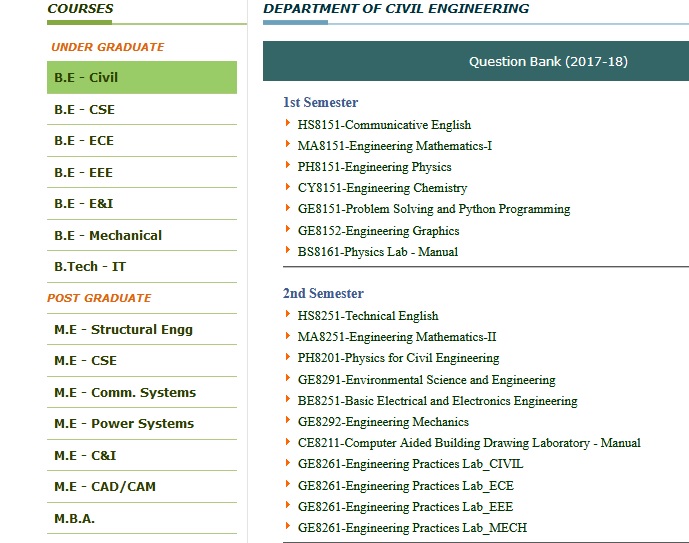ET7104 Design of Embedded Systems M.E Question Bank : valliammai.co.in
Name of the College : Valliammai Engineering College
University : Anna University
Department : Electronics & Instrumentation Engineering
Subject Code/Name : ET7104- Design of Embedded Systems
Degree : M.E C&I
Year : I
Semester : I
Document Type : Question Bank
Website : valliammai.co.in
Download :https://www.pdfquestion.in/uploads/va…%20Systems.pdf
Valliammai Design of Embedded Systems Questions
ET7104- Design of Embedded Systems Question Paper
Related : IT2402 Mobile Communication B.E Question Bank : www.pdfquestion.in/2864.html
Unit-I
Part-A :
1.Tabulate the difference between microprocessor and microcontroller
2.What are the issues in selecting the processor for an application
3.List the different phases involved in the embedded system design life cycle
4.What is embedded system
5.Name the specific suites of benchmark organization
6.What is meant by inline assembly code
7.Name the hardware and software debugging tools
8.What is an embedded system
9.What is EEMBC
10.What is the use of device drivers

11.What is meant by Time to Market factor
12.Name the performance measuring tools
13.What is Dhrystone benchmark
14.Name any four factors for selecting the RTOS
15.Name any four features for the selection of compiler
16.What are the issues in selecting a processor
17.What is meant by SoS
18. What do you understand by the term memory substitution
19.What are the three broad categories available to evaluate tool chain
20.Why do we need RTOS for embedded application
Part-B :
1.Explain hardware /software portioning process with an example
2.How the performance tools helps in analyzing the performance of the system
3.What are the challenges in product integration and how to test the product
4.Explain the product specification process with an example
5.Discuss the various factors to be considered for the selection of RTOS
6.Explain about various bench marking
7.Explain various issues in the selection process
8. Explain the Hardware/Software integration process with an example
9.Explain in detail about embedded design life cycle
10.Explain in detail about tool chain availablity
Unit-II
Part-A :
1.How to optimize the code and speed density
2.What is firmware
3.Define the term linker
4.Define reentrant function
5.What is coverification process
6.What do you mean by HW/SW duality
7.What is the key part of creating an embedded system
8.What is silicon compilation process
9.What is the importance of ASIC in embedded system
10.Draw the block diagram of hardware and software duality
11.What is meant by code space
12.What is meant by unpopulated memory space
13.Define the term data space
14.Write the design steps for code the hardware
15.Give some examples of ASIC Technology
16.Write steps while asserting an interrupt signal
17.Define the term start up code
18.State the advantages of relocatable module
19.What is virtual HW/SW integration
20.What is meant by ASIC revolution
Part-B :
1.Illustrate how to code the hardware in the view of HW/SW duality
2.Write briefly about nested interrupts and reentrancy
3.Write briefly about object placement
4.How to write the coding for both hardware and software development
5.With example explain how the risk management is achieved
6.Explain in detail about memory organization and enhancement
7.Explain how coverification is done
8.Explain in detail about the memory organization of 68k microprocessor and how it is started up
9.Explain in detail about silicon compilation process
10. Describe the memory access procedure What is the use of chip select function PREPARED BY Ms. F. AGI LYDIA PRIZZI /A.P (O.G)
Unit-III
Part-A :
1.How does the host based debugging perform
2.What is meant by shadow register
3.How watch dog timers protect the system
4.What are the advantages of logic analyzer
5.What is watch dog timer
6.Draw the watch dog timer flow diagram
7.Name the run control services provided by debugger
8.Name the advantages of debug kernel
9.What are the elements of ROM Emulator
10.State the limitations of ROM Emulator
11.What is the use of logic analyzer
12.What are the modes of operation of logic analyzer
13.Draw the schematic representation of logic analyzer trace and trigger system
14.Define the term In System Programming
15.State the difference between In System Programming and In Application Programming
16.What is meant by symbolic triggering
17.Write the advantages of ROM Emulator
18.State the uses of ROM Emulator
19.What is meant by break point
20.What is meant by state mode
Part-B :
1.Write short notes on symbolic triggering
2.With functional block diagram of typical ROM emulator explain its operation
3.Explain in detail on the JTAG Emulator
4.Explain how timers and counters are useful in system design
5.Explain the flash memory and RAM organization in a controller
6.What is in system programming what are the advantages of ISP
7.Explain how ROM emulators helps in debugging operation
8.Explain logic analyzers in detail
9.Explain Host based debugging and remote debugging in detail
10. With functional block diagram of watch dog timers explain its operation